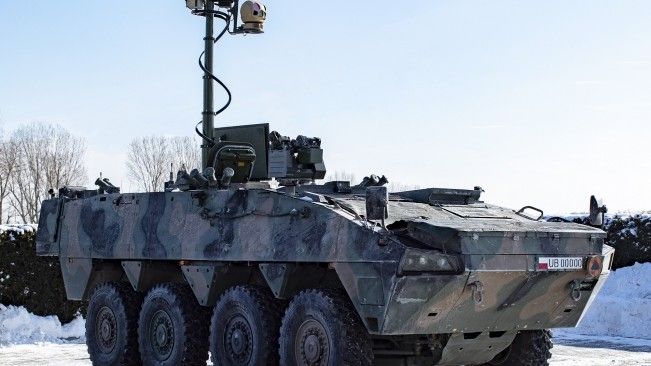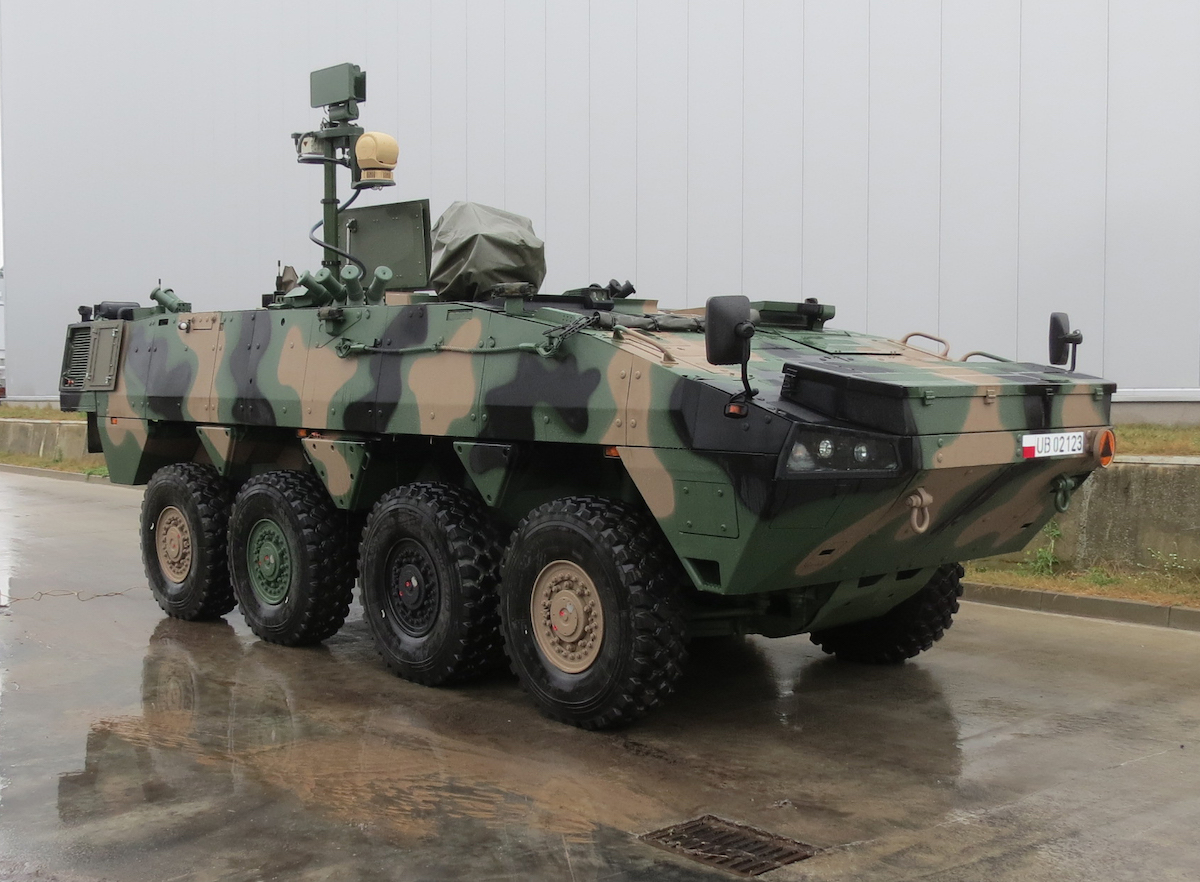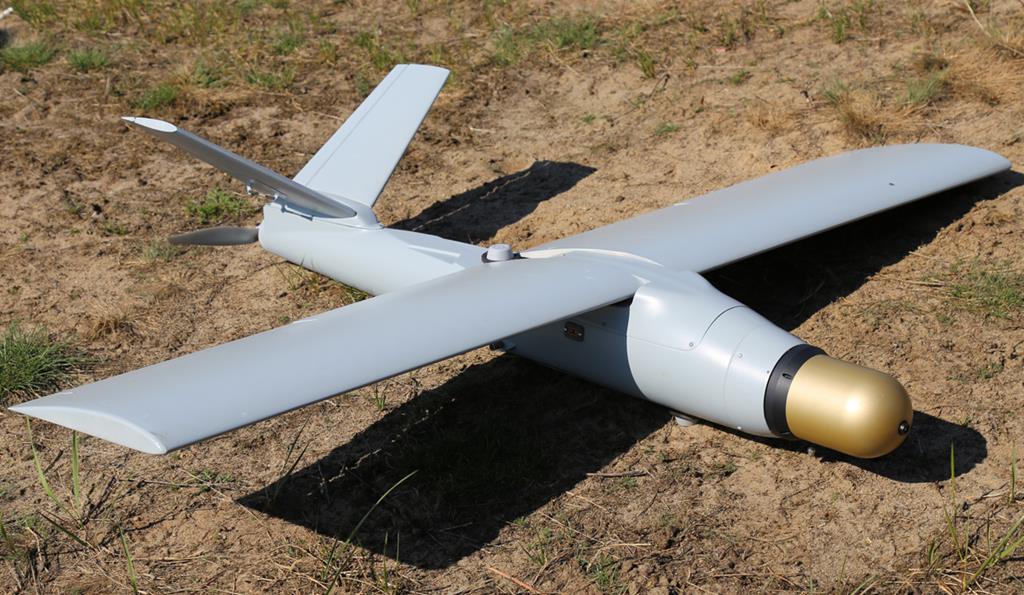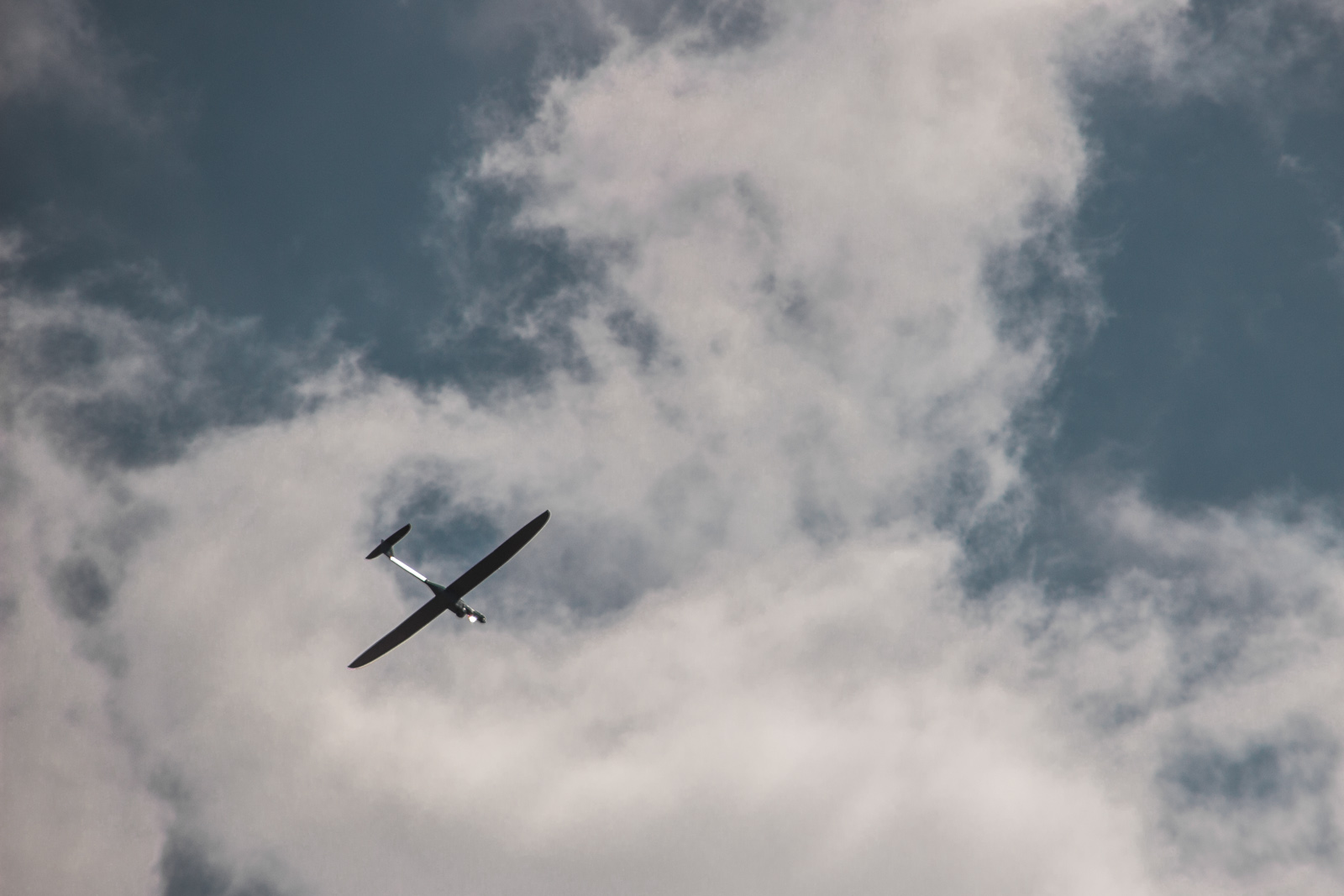Armed Forces
AWR - “Eyes” of the Polish Artillery (and Beyond) [ANALYSIS]

Photo. Grupa WB
The introduction of the AWR platform (Artyleryjski Wóz Rozpoznawczy, Artillery Reconnaissance Vehicle) is going to be a major reinforcement for the artillery elements operating the Rak self-propelled mortars. These units would be the first to receive these vehicles. Equipment as such may create a generational leap for all of the Polish artillery units, both thanks to the support provided to a variety of assets, as well as thanks to the integration of unmanned systems - both the ones used for reconnaissance, as well as the unmanned strike assets.
In mid-March 2021, a test programme was finalized concerning the AWR artillery reconnaissance vehicle, based on the Rosomak APC. The vehicle is to become a part of the company-level Rak mortar fire modules - the Rak self-propelled mortar platform operated by the Polish military uses the Rosomak APC as the base platform as well. The Polish Ministry of Defence has procured such mortars for 15 company-level fire modules. Eight of those modules have been already commissioned. The remaining ones are to be consequently delivered over the next 3 years.
Along with the self-propelled mortars, the land forces are also taking deliveries of Rosomak-based command vehicles, and support vehicles that would secure the logistics - AWA ammunition carriers, and AWRU repair vehicles. Two latter vehicles use Jelcz trucks as the base platform. All of the Rak module vehicles have also been fitted with Topaz automated fire control system manufactured by the WB Group - a subcontractor in the consortium led by HSW S.A., delivering the Rak mortars.
Reconnaissance platforms for the artillery units are the last piece of the puzzle when it comes to the fire modules. The timeline shift for the project was caused by the fact, that the carrier platform, in its original configuration - the AMZ Żubr - did not pass the qualification tests. The issues that caused doubts were not related to the specialist equipment, as they pertained primarily to the vehicular platform itself.
Back in December 2018, an agreement annex was signed, making it possible to change the carrier to Rosomak APC. The integration progressed very rapidly. In the first quarter of this year, an announcement was made on the finalization of the qualification test programme which paves the way towards agreeing on delivery of these vehicles.
What is the AWR Platform?
Carrying out recon tasks for the artillery elements would be the primary purpose of the AWR platform. This would be done with the use of two sensor sets: onboard one (with battlefield radar and optoelectronic sensor on a mast), and portable one (with APDR artillery reconnaissance/rangefinding instrument, featuring a TV camera, thermal imager, laser rangefinder, digital compass, and a goniometer).
Thanks to the fact that both the AWR, as well as the remaining Rak module elements, utilize the Topaz fire control system, the data is transferred in an automated manner, almost in real-time. This happens in a manner identical to the one associated with other reconnaissance systems using the Topaz solution, that are already a part of the Polish Armed Forces' inventory (APDR, Liwiec firefinder radars, FlyEye UAVs). AWR can support and provide reconnaissance data to other elements using the Topaz system - including those operating the Dana or Krab howitzers. This is a novelty in the Land Forces. Nowadays, only the artillery units remain capable of transferring the information in an automated manner, with the use of the Topaz system.
This capacity used to be available only at the squadron, and regiment levels. Now it becomes also a part of the set of capabilities available to support companies at the level of mechanized/motorized battalions. These elements have their situational awareness levels enhanced, especially in a situation when reconnaissance assets are provided to the support company from the higher levels (such as the FlyEye UAV). The introduction of the AWR vehicle is yet another step - as simply another "sensor" would be connected to an already functioning C2 system.

The WB Group's representatives stress that, in practical terms, a BMS-class solution is implemented in this way, in motorized battalions. Topaz features all of the basic BMS system functions, when it comes to the transfer of data on blue and red forces, and also regarding the creation of the operational picture. This is possible without the Rosomak BMS system (that is yet to be ordered), which would provide the user with a digital BMS capability in mechanized battalions. All of the Rosomak APCs are expected to use the aforesaid solution. One should stress the fact that the WB Group also offers the TOPAZ system with data transfer protocols compliant with the STANAG norms (STANAG 5500, 5525, 5527). This compliance has been tested, in multiple scenarios, during the CWIX interoperation exercises.
The introduction of the AWR vehicles at the company level would translate into a major reinforcement of the potential of these elements. It could redefine how artillery elements gather intel entirely. Although APDR systems used to be used for that purpose in the past (with forward observers/infantry equipped with them, often using standard all-terrain vehicles/trucks), now, the artillery units will have an ability to carry out the very same tasks, with the use of a vehicular platform directly. No necessity would emerge to leave the vehicle, and the platform would be able to precisely designate the detected targets and upload the data to the fire control system. Should a need as such present itself, the reconnaissance task can still be carried out with the soldier staying outside the vehicle.
AWR may be used to carry out reconnaissance tasks with the use of the battlefield radar that is mast-mounted - a sensor that makes it possible to detect and track enemy assets at distances of up to several kilometers, with the vehicle still unexposed, thanks to the mast. The SR Hawk radar may also work in a firefinder mode. As the vehicle also features an optoelectronic sensor, the targets detected by the radar may be rapidly identified.
The AWR platform also features the ZSMU remote control weapons station, used for self-defence purposes. A vehicle as such may play an important role in defending its forces (such as artillery elements), in the areas where they are deployed. The reconnaissance equipment may be used to detect the operational activities of the sabotage/recon squads of the potential adversary.
Rak and Beyond...
Even though AWR is going to become a part of the Rak modules, the capabilities that it has are also desirable in other artillery elements - including the ones operating the Krab howitzers. The introduction of reconnaissance platforms had been originally planned for the Regina programme after all. However, they were not included in the configuration of the modules mainly due to the lack of a proper 4x4 carrier platform. For the same reason, no command vehicles were introduced at the platoon/battery level, alongside the Langusta rocket launchers. Ultimately, as we know, in the case of the Rak system the reconnaissance vehicle would not be based on a 4x4 platform, but on an APC. This will make platform unification easier.
One should remember that reconnaissance equipment of the AWR platform is universal. It may be integrated on a variety of carrier platforms, depending on the requirements - this has been proven by the transfer of that kit from Żubr, to the Rosomak APC.
Depending on the needs, further artillery modules may receive vehicles based on the same platform (Rosomak APC), other wheeled platforms, or a newly developed 4x4 or tracked vehicle - the latter projects are being pursued by HSW. The LPG light tracked platform could potentially be used for that purpose (used as the Krab elements command vehicles). The new Opal family platform may also be a good solution here. As one may expect, in a few years, as the Rak mortars utilizing a tracked platform are implemented, another AWR variant would be designed.
One needs to stress the fact that using a variety of platforms for artillery reconnaissance assets, utilizing a homogeneous equipment suite, is nothing new. In the US, the artillery units operate a myriad of platforms with a unified reconnaissance system featuring an optronic sensor. The base platforms are varied and include the following: Bradley IFV (M7 Knight), Stryker IFV (Stryker Fire Support Vehicle), and 4x4 vehicle (M1200 Armored Knight). What is interesting, both M7, as well as M1200 platforms are used by different units within the armoured brigades.
The Bundeswehr also operates two types of vehicles for the observers and support controllers: Fennek JFST (light platform), Marder IFV (heavy platform). The introduction of the AWR vehicle into the Rak module structure shall be only the first step in the modernization of the Polish artillery component within that scope. Ultimately, platforms offering a similar set of capabilities should become a part of all artillery squadrons. A few years ago, HSW was demonstrating concepts that envisaged the delivery of vehicles as such.

Beyond the Artillery Units
AWR vehicles could also be useful outside the artillery elements. They may be used to support general recon, and to coordinate fire support called for by the forward operating elements.
The reconnaissance elements within the units operating the Rosomak APC operate the standard variant of Rosomak, and the obsolete BRDM-2 platform. The introduction of specialist vehicles here could have a relevant impact on the available capabilities. The modernization plans defined by the Polish MoD include the Rosomak R1/R2 reconnaissance APC programme. Nonetheless, the R&D project within that scope is still being pursued. No information has been disclosed, when it comes to the finalization of that project.
A derivative of the AWR vehicle may also be developed for use by JTACS. Platforms as such should feature a communications suite that would allow them to communicate directly with the air force units. Fennek JFST is being used similarly - in joint two-vehicle elements, one is used by the artillery observed, and one by the FAC. The Polish AWR's distinguishing feature is the inclusion of the radar in its mission suite. The German artillery operates a separate radar carrier - the upgraded M113 ABRA system.
Further Steps
The AWR's configuration may be enriched with elements tied to the use of unmanned systems. This refers primarily to the FlyEye UAVs (known to the Polish artillerymen), but also to the Warmate loitering munitions system, introduced by the Polish military in January 2021. Both systems are integrated with the Topaz solution fully. They also utilize identical control/data link systems. Furthermore, the SWARM strike/reconnaissance system, recently developed by the WB Group, provides the user with the ability to embed the artillery assets and loitering munitions within a single battle system.
Once SWARM is introduced, it would be possible to attack targets detected by the Topaz-integrated assets (AWR/UAVs, ADPR systems) with the use of artillery, or loitering munitions, depending on the circumstantial needs.
When it comes to the AWR system itself, there are several development paths for the equipment expansion, so that it is possible to use the platform jointly with the UAVs. The first, and the simplest one is the addition of C2 systems needed to control the FlyEye/Warmate UAVs. This would allow the AWR vehicles to control the UAVs, even if these take off several miles away, safe from harm present in the conflict zone.
One may also pursue a path in which UAVs (reconnaissance ones in particular) become a part of the AWR equipment package. Similar steps were taken when the WSRiD (Multi-Sensor Reconnaissance and Surveillance System) carriers were introduced in the 12th and 17th Mechanized Brigade. Even though the aforesaid vehicles were procured with the Afghan deployment in mind, they have become a part of the inventory of the Brigades. The FlyEye UAVs integrated with them are the first (and so far - the only) platforms of this class, operated by the mechanized brigades of the land forces.

The introduction of more Topaz-integrated UAVs into the inventory of the artillery elements (squadrons, support companies), is a separate matter. As the number of modern assets is growing (Krab, Rak), the requirements within the scope of reconnaissance are also growing. Meanwhile, the option of using loitering munitions would provide the artillery units with an extra set of capabilities, already integrated into the solutions operated today.
Bringing Reconnaissance to a New Level
The introduction of the AWR platform in the support companies operating the Rak mortars would make it possible to complement the combat modules, thus expanding their capabilities. These vehicles fuse mobility with an advanced sensor suite, and the Topaz system, allowing them to transfer data in an automated manner. The needs the Polish Armed Forces have when it comes to reconnaissance assets (including vehicular platforms of this kind) are far broader.
Furthermore, the AWR platforms may also serve as a reinforcement of the recon units in general. They could also be developed further. The specialist equipment could be integrated on new platforms, and new capabilities may be added, based on specialist equipment. In particular, the above refers to joint operations involving UAVs, and UCAVs. All of the above assets shall be gathered within a single C2 solution that already remains in use in the Polish military.
Article prepared in collaboration with the WB Group.
